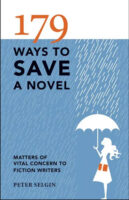Apollonian or Dionysian?
The rudimentary jacket design of this book is deceptive—you suspect 179 Ways to be another generic book on craft. Not so. What you have here is a treasure trove of writing insights delivered in no-nonsense fashion by a natural teacher and wordsmith. Peter Selgin expertly balances analysis of craft with the more elusive elements of art to deliver a masterful study of fiction at its best.
179 Ways begins by addressing that perennially perplexing issue—is autobiographical material taboo? No, Selgin says, so long as you deftly employ the imagination to elevate the substance of your story into the realm of art. The challenge lies in sifting through the dross to find the dream—fresh events that defy mere anecdote, have a current of emotional significance, and a sense of inevitability.
Selgin supports his flow of ideas with pertinent references to successful stories and novels. What often distinguishes the master works, he says, are two things: a sense of authenticity and an unswerving flair for storytelling. In other words, be true to the work and find the drama in your tale.
Let me finish this brief commentary with a Selgin quote from the final section, “Each of us must strike our own balance between Apollonian impulses (harmonious, measured, ordered) and Dionysian (wild, orgiastic, unbounded) . . . . However we do it, somehow we have to find ways to put our own visions into the heads of strangers.”
After 30 years of collecting books on the art and craft of writing, three hundred of them grace my study shelves. Peter Selgin’s text is one of my top five.
179 Ways to Save a Novel by Peter Selgin. Writer’s Digest Books, 2010.
Reviewer bio: James Gering is a poet and short story writer from the Blue Mountains in Australia. He welcomes visitors at jamesgering.com.





